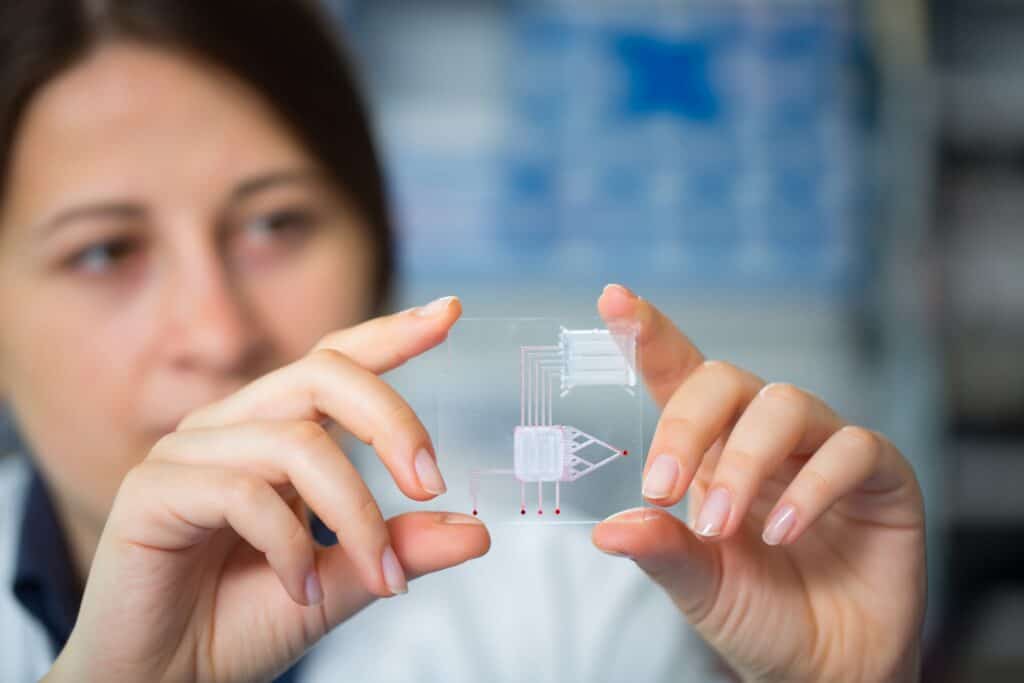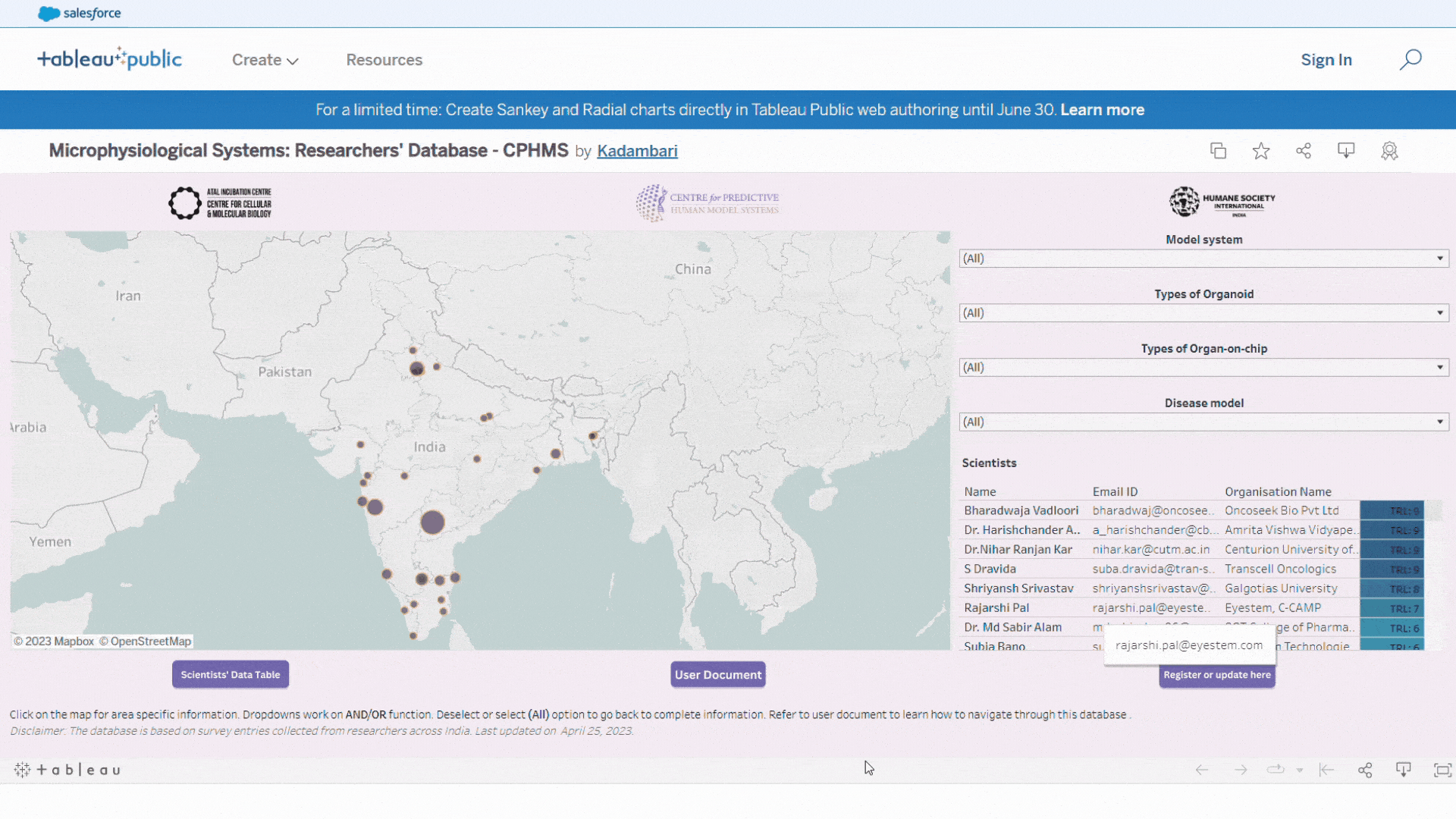CPHMS launches India’s first MPS Database
1 June 2023

by Kadambari Patil, Centre for Predictive Human Model Systems
Globally, research using microphysiological systems, including organoids and organ-on-chip systems, has grown significantly in the last decade. Their ability to improve predictive accuracy[1] while lowering the ethical and scientific limitations associated with animal testing during disease modelling and drug development have propelled their growth.[2]
In India, the acceptance and development of New Approach Methodologies (NAMs) are gradually gaining momentum.[3] Although several research laboratories and start-ups in the country have commenced work on human-relevant models, most of them remain in silos, a factor that continues to limit progress.[4]
The need for a database
In many fields of biomedical science, interdisciplinary collaboration between researchers from diverse backgrounds stands at the heart of efforts to solve complex research questions.[5] Mimicking the architecture, function, and likeliness of human tissue in lab-grown 3D tissues and organ-chips requires an interdisciplinary approach and collaboration between researchers from diverse backgrounds, such as cell biology, engineering, computational biology etc. Currently, however, there are no platforms that provide the opportunity for this crosstalk and exchange, which will be necessary if the field is to flourish in India. This deficit of sharing leads to duplication of efforts, prevents shared learning and technology transfer, and delays the emergence of preliminary results that could move such projects forward.
In September 2021, the Centre for Predictive Human Model Systems (CPHMS) at the Atal Incubation Centre – Centre for Cellular and Molecular Biology (AIC-CCMB) organised a multistakeholder roundtable for discussions centering on the development of MPS models in India. One important recommendation that resulted was to build a database to capture the number and diversity of researchers working in this space. This would be beneficial to both researchers (by driving collaboration and open communication) and to regulators and government bodies seeking to understand this growing ecosystem in India.
Setting the database into action
In April 2023, CPHMS launched an open and user-friendly interactive ‘Microphysiological Systems: Researchers’ Database’ encompassing the research interests of over 60 scientists working on various kinds of organoid and organ-chip systems. The database maps the geographic distribution of scientists working on MPS across India and allows access to details like the specific model system being developed, its technology-readiness, and the diseases being researched. The user can filter and sort the data according to specific interest (see demo below).

This is a first-of-its-kind comprehensive resource for researchers and stakeholders involved in non-animal, human-relevant methodologies in India. The database relies on data collected in a survey of MPS researchers across India over several months in 2021-22. The data was meticulously sorted to include group leaders or principal investigators only. Using Tableau Public and Tableau Public Resources, the data was integrated and prioritised to enable and enhance user interaction. A user document assists navigation of the database. At the moment, the database remains manually curated, but it will be automated in the future.
This database includes not just academic centers but industry interests and start-ups working on MPS systems. Thus, both scientists and industry personnel can properly assess the research landscape, form collaborations and draw on the expertise of their peers, forging stronger and more productive academia-industry collaborations.
Using this database, CPHMS also attempted to identify gaps in the training and infrastructural needs of researchers working in this area. This information could serve as a resource for government and regulatory bodies in policy formation and allocation of funds to specific areas of MPS in India, such as training, research, and infrastructure development for NAMs.
Regardless of their project size, scientists in the field will benefit from participation and sharing their information, ensuring that smaller projects and unpublished research also gain visibility.
Other notable databases
Given its primary focus on human-relevant and non-animal models, the ‘Microphysiological Systems: Researchers’ Database’ database is a steppingstone for India’s efforts to strengthen its position as a global contributor in the field of NAMs. Similar databases in other fields, such as ‘Vidhwan’ by the Department of Science & Technology (India) have already demonstrated the value of enhanced collaboration in the science ecosystem. One inspiring example has been the ‘Interactive Database of Life Science Researchers in India’ by IndiaBioscience.[6]
University of Pittsburgh’s MPS Database is an example of an international and advanced database in a relevant field. This complex database not only maps scientists’ data but also covers the framework of MPS research that is an important resource for scientists and regulatory bodies. The resource allows comparison of advances in the field of NAMs and existing science policies.
Fast forward
In the coming few years, CPHMS hopes to evolve ‘Microphysiological Systems: Researchers’ Database’ into a platform for discussion, troubleshooting, and resource sharing for stakeholders involved in MPS research. In addition, it promises to be a repository for emerging data based on various MPS models from India which could facilitate better and more consistent regulatory decisions.
Researchers, stakeholders, and the wider scientific community are invited to access, engage and contribute to the Microphysiological Systems Researchers’ Database.
Share your thoughts below on how CPHMS can encourage collaborations.
[1] https://www.nature.com/articles/s43856-022-00209-1
[2] https://www.ncbi.nlm.nih.gov/books/NBK574094/#sec_6
[3] https://www.ncbi.nlm.nih.gov/pmc/articles/PMC6702685/
[4] https://link.springer.com/article/10.1007/s12038-020-00112-8
[5] https://www.ncbi.nlm.nih.gov/pmc/articles/PMC3652225/#R2
[6] https://indiabioscience.org/projects/lifescientists-database/map

Post a comment